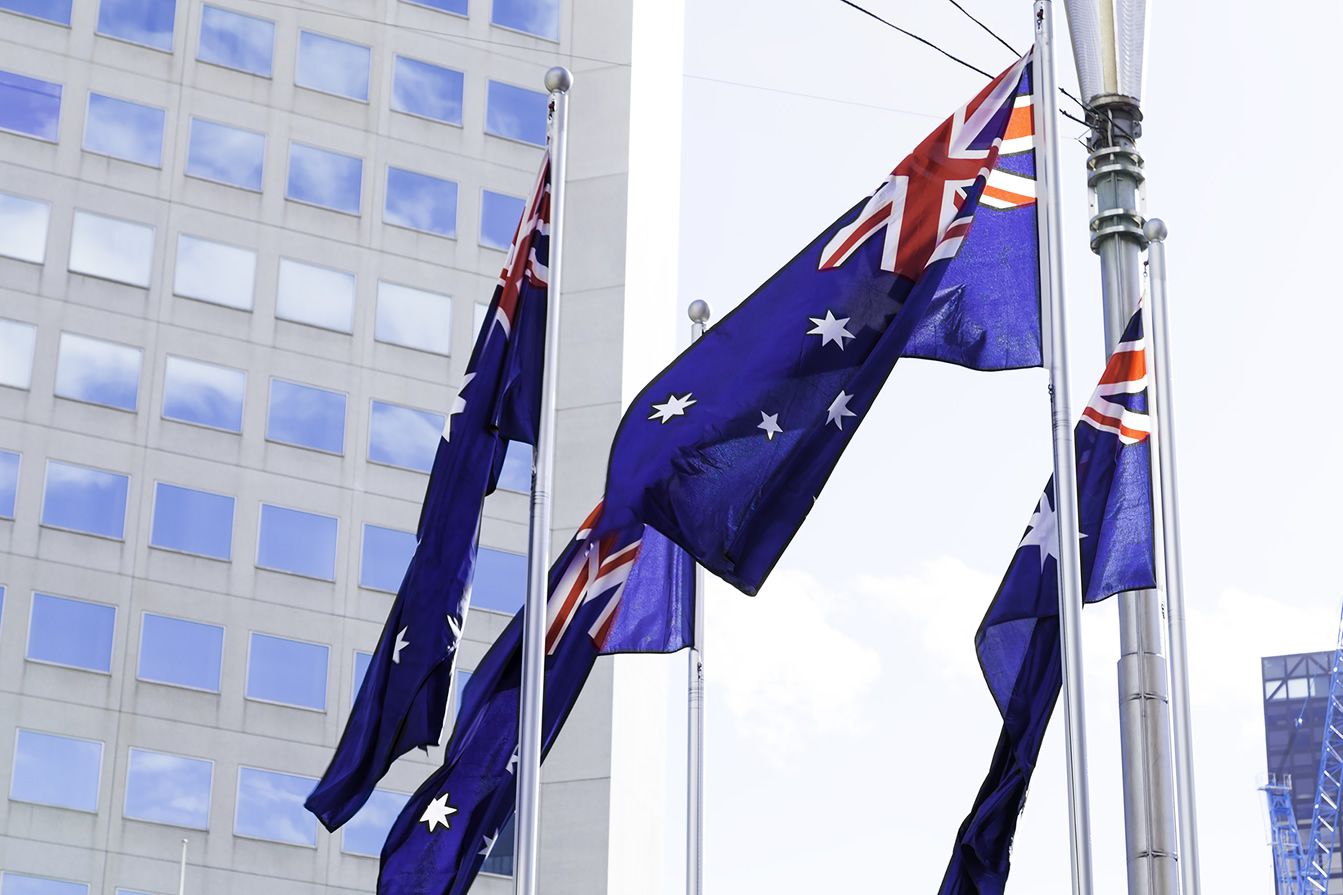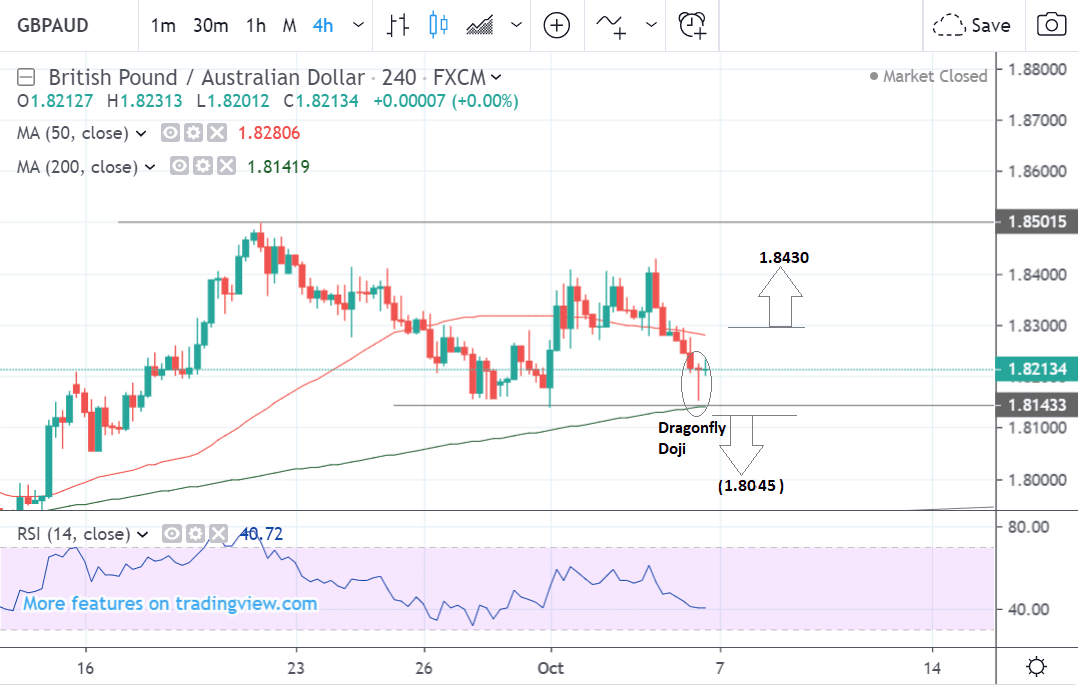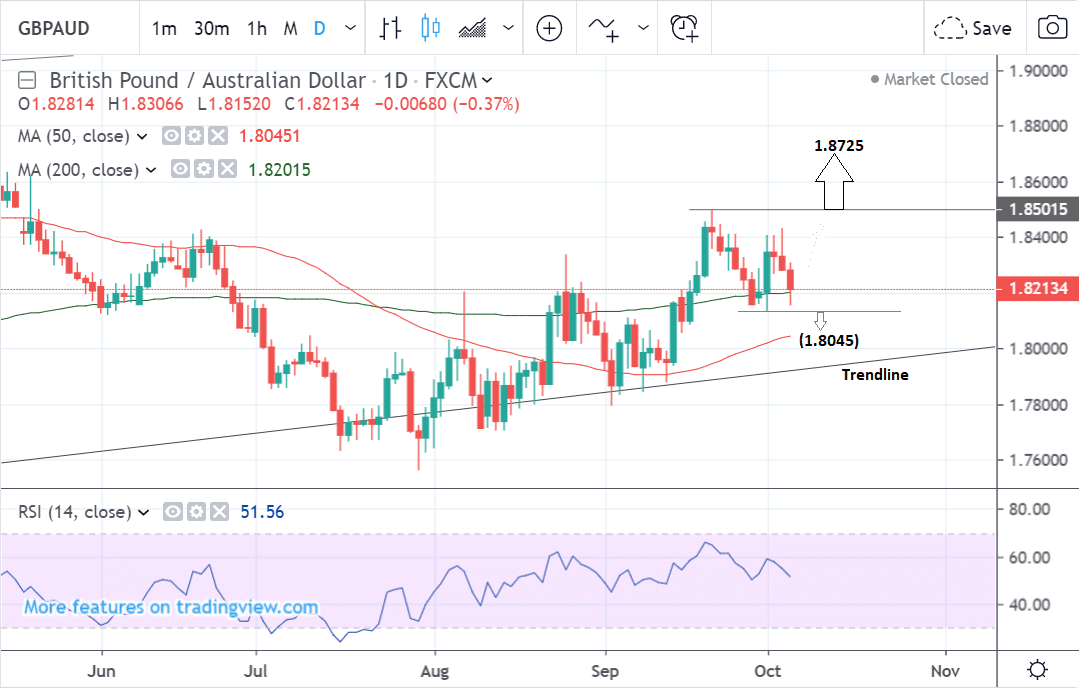Pound / Australian Dollar Forecast for the Week Ahead: Trading With a Slight Bullish Bias

Image © Adobe Images
- GBP/AUD rising within a channel
- Holding above 50-week MA
- Critical week for Brexit negotiations to boost volatility in Sterling
- Aussie by U.S.-China trade talks and sentiment data
The Pound-to-Australian Dollar exchange rate is trading at around 1.8213 at the start of the new week after rising a marginal 0.30% during the week before. The pair is trading with a slight bullish bias within a rising channel.
The 4 hour chart - used to determine the short-term outlook, which includes the coming week or next 5 days - shows the pair oscillating within a range.
It has just reached the bottom of the range and formed a bullish ‘dragonfly doji’ candlestick pattern.
This could be a sign it is about to reverse and start rising.
If the next candlestick is also bullish it could indicate a continuation up to a target at the 1.8430 October highs.
Alternatively, there is a possibility that, notwithstanding, the dragonfly doji’s bullish connotations the pair may decline instead.
The look-and-feel of the most recent tranche of price action marginally preferences further downside.
A break below the 1.8120 level would probably confirm a continuation lower to a target at 1.8045 where major support is likely to hold up the exchange rate.
The daily chart shows how the pair has steadily risen since the July 30 lows.
Given the old adage that ‘the trend is your friend’ this uptrend is likely to continue.
A break above the 1.8500 September 20 highs will probably open the way higher to a target at 1.8725.
There is also the possibility of a continuation of the current sell-off lower to a target at 1.8045 and the 50-day Moving Average (MA).
Large MAs often act as barriers to further sell-offs and the pair will probably stall at that point, before potentially making a recovery.
The weekly chart is starting to look more bullish since the pair broke above the 50-week MA 3 weeks ago and has since held above.
The longer-term trend is also bullish providing a backdraught for more upside.
A break above the 1.8500 high would provide a strong bullish signal suggesting a continuation higher to a target at 1.8880.
The weekly chart is used to give us an idea of the longer-term outlook, which includes the next few months.
Time to move your money? Get 3-5% more currency than your bank would offer by using the services of a specialist foreign exchange specialist. A payments provider can deliver you an exchange rate closer to the real market rate than your bank would, thereby saving you substantial quantities of currency. Find out more here.
* Advertisement
The Australian Dollar: What to Watch

The main drivers of the Australian Dollar in the week ahead are likely to be the progress of trade talks between the U.S. and China, and Australian sentiment data on Tuesday and Thursday.
A fresh round of trade talks between the U.S. and China is scheduled to begin on Thursday and although previous talks have ended in no deal this time there is more optimism something could materialise.
Both sides could have more of an incentive to do a deal, according to Marios Hadjikyriacos, an investment analyst at XM.com.
Donald Trump may wish to lessen tariffs on agricultural exports in order to appease his rural electoral base in the run up to next year’s elections.
China’s economy has suffered from the fall out from the trade war and it may wish to prevent any further decline in growth.
If an interim deal is agreed it will lead to a rise in the Australian Dollar since it is highly exposed to China because of the two country’s close trade ties.
A failure to reach a deal, however, would have the opposite effect and probably push down the Aussie.
Australian sentiment data is also out in the week ahead and this is often a leading indicator for the economy.
NAB business confidence data in September is first up when it is released on Tuesday at 1.30 BST. The previous result was a balance of 1 suggesting slight optimism.
Consumer sentiment data in October is out on Wednesday at 00.30. In the previous month it showed a decline of -1.7%.
The results of these surveys may impact on interest rate expectations and the Aussie.
The Reserve Bank of Australia (RBA), which sets base lending rates for the economy, uses economic data to decide whether the economy needs lower interest rates to help stimulate growth or higher rates to cool it down.
Lower rates weaken the Aussie because they attract lower inflows of foreign capital looking for somewhere to sit and earn interest, and vice versa for higher rates.
Recently the RBA has been cutting interest rates aggressively leading to a weaker Aussie, and more negative data, even sentiment data could lead to increased expectations of even lower rates, and further declines in the currency.
The Pound: What to Watch

Brexit news will continue to dominate the Pound in the week ahead, whilst on the hard data front industrial and manufacturing production are the main releases along with the second estimate of Q2 GDP.
From a Brexit standpoint, the main focus will be on whether the UK and EU can strike a deal or at least a semblance of a deal - if they can the Pound could rise strongly. Dominic Cummings, a leading force behind the UK's Brexit strategy, has reportedly told aides that if the EU do not strike a compromise and agree to a new plan this week then the UK will be leaving without a deal.
The stakes are certainly high, particularly as there is very little insight into how Prime Minister Boris Johnson intends to exit the EU without a deal on October 31.
According to government papers submitted to a Scottish court on Friday, Johnson will send a letter to the European Union asking for a Brexit delay if no divorce deal has been agreed by October 19. This means the Government intends to abide by the Benn Act which forces the Prime Minister to seek a Brexit extension if a deal has not been passed by parliament on October 19.
However, the British Pound actually went lower on the day as Government sources maintained that while they intend to follow the law, they will still not seek a delay. Steve Baker, the Conservative MP who heads up the party's Eurosceptic European Research Group responded to the government's court papers saying: "a source confirms all this means is that Government will obey the law. It does not mean we will extend. It does not mean we will stay in the EU beyond Oct 31. We will leave."
The UK recently submitted an alternative proposal to solve the problem of the Irish 'backstop' but the initial reaction of leading EU Brexit negotiators and stakeholders was not very positive and suggests the two sides were a long way from meeting in the middle.
Leo Varadkar, the prime minister of Ireland, said the UK’s present proposals “do not form the basis for deeper negotiations.”
The EU's chief Brexit negotiator Michel Barnier said, “there’s improvement...we are not there yet,” but privately was concerned about the proposal’s custom’s checks on the island of Ireland, a red-line for the EU.
Guy Verhofstadt, who heads up the EU Parliament's Brexit oversight committee commented that the proposals were “not positive in that we don’t think really there are the safeguards that Ireland needs.”
The proposal was however well-received by the government’s own party, however, including leading Brexiteers on the one hand and rebel Tory independents on the other. We noted that there is a decent chance the Government could win a majority were they to present a deal based on their latest plans, and this is an all-out positive development for Sterling.
A deal still looks to be some way off however as the further the government moves to meet the demands of the EU, who basically want a customs union in Ireland, the more it will alienate the ERG and DUP, without whose support it has no chance of getting the deal approved by Parliament.
This may overall lead to further pressure on the Pound in the week ahead.
Turning to the economic data, investors will be closely watching industrial and manufacturing data, which are both expected to show a -0.1% result in August from 0.1% and 0.3% respectively in July, when released on Thursday and 9.30 BST.
A combination of Brexit uncertainty and the global manufacturing slowdown have started to show up in British economic data and the recent Services PMI report said there was a heightened chance of a technical recession happening in the UK.
If the results show a deeper-than-expected contraction in the data the Pound will probably weaken.
Q2 GDP is expected to remain unrevised for its second estimate, with the quarterly reading to continue to show 0.0% growth, yearly 1.3% and monthly 0.3%.
If results are revised down the Pound will follow suit.
Time to move your money? Get 3-5% more currency than your bank would offer by using the services of a specialist foreign exchange specialist. A payments provider can deliver you an exchange rate closer to the real market rate than your bank would, thereby saving you substantial quantities of currency. Find out more here.
* Advertisement








